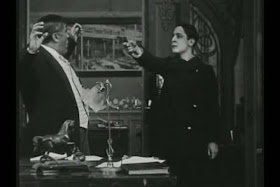One of the great pleasures of watching cinema’s rich history in chronological order is the ability to witness a great director’s artistic evolution. Swords and Hearts sees Griffith move away from the ‘morality play’ structure of his earlier films Corner in Wheat (1909) and The House with Closed Shutters (1910). Whereas these two films focused on a single theme (greed in the former and cowardice in the latter), thus limiting the dramatic potential of both films, Swords and Hearts sees Griffith adopt a more expansive method of storytelling.
This is an incredibly important development for Griffith, because it allowed him to maximise the dramatic potential of his greatest strength – interweaving storylines. As they are no longer inhibited by a simple moral theme, the characterisation deepens and the narrative becomes more gripping.
In Swords and Hearts, this developed approach to the film’s narrative allows the Griffith to move away from the morality play and into the territory of melodrama. Today, the term melodrama has negative connotations and is associated with mediocre television films; however, the genre can be extremely satisfying.
Sidney Lumet once observed, "In a well-written drama, the story comes out of the characters. The characters in a well-written melodrama come out of the story." Swords and Hearts sees Griffith return once again to the American Civil War – which allows him to create a story filled with class resentment, unrequited love and some extremely impressive set pieces. Although Hollywood would be loathe to admit it, melodrama shares many similarities with the modern ‘summer blockbuster’; Griffith sets a loose template for such films with Swords and Hearts.
Griffith himself.
A useful way of illustrating Griffith’s artistic maturity in Swords and Hearts is to compare the use of a device which is used both in this film and one his earlier films, the House with Closed Shutters. In both films, we see female characters cross-dress in order to pretend that they are Confederate soldiers. In the latter film, this is done to illustrate the cowardice of the main protagonist. Although it does provide us with the powerful image of the sister being killed carrying the same flag that she was sewing at the opening of the film, the device’s main purpose is to make a moralistic observation.
In Swords and Hearts, the soldier Hugh is unaware that his horse has been taken. Jennie sees the soldiers from the North approaching and steals Hugh’s horse so that the approaching soldiers do not see that he is in Irene’s house.
What follows is the most gripping action sequence that we have seen in any film to date. She is chased by the soldiers, but at such a breathtaking speed that even a modern audience are taken aback by this high speed horse chase. The angling of the camera allows the speed to be heightened; when a gun fight ensues, you cannot help but marvel at the pace at which it unfolds. It certainly adds weight to the argument that CGI and special effects cannot match the effect of action sequences that are shot without any post-production manipulation.
Returning to Jessie’s decision to don the confederate uniform, the importance of this decision serves as both the catalyst for the central part of the film as well as bringing the two protagonists together by the end of the film. Although we now treat sentimental happy endings with an element of disdain, you cannot help admiring the manner in which Griffith brings the various strands of his plot together.
Another stand out set-piece is the burning down of Hugh’s house. The only parallel we have of such a dramatic scene is the burning of the house at the climax of The Story of the Kelly Gang; on this occasion, however, we are presented with footage of the burning house from the inside. We can only speculate as to how dangerous such filming was in 1909, but there is no denying the raw power of this sequence of images. The image of the house being engulfed by flames is as riveting an image as we have encountered to date; the untamed malice of the flames is deeply unnerving.
The film also brings Griffith’s contentious portrayal of African-Americans to the fore. Old Ben is Hugh’s father’s slave and has a pivotal role in ensuring that Hugh maintains his family’s heirlooms as well as bringing Hugh and Jennie together. Unfortunately, he is portrayed in ‘blackface’. His over-exaggerated mannerisms and gestures undoubtedly make a modern viewer extremely uncomfortable, which in turn affects our overall aesthetic judgment of Griffith's oeuvre. I would be interested to learn what effect such crass portrayals of a race had on other viewers...






























